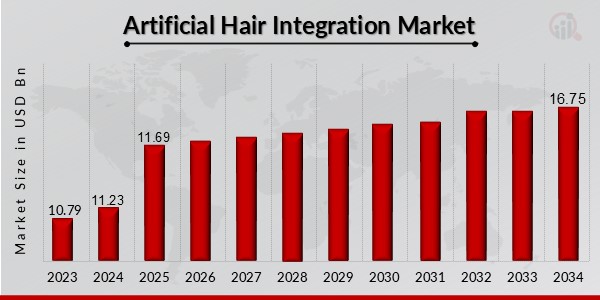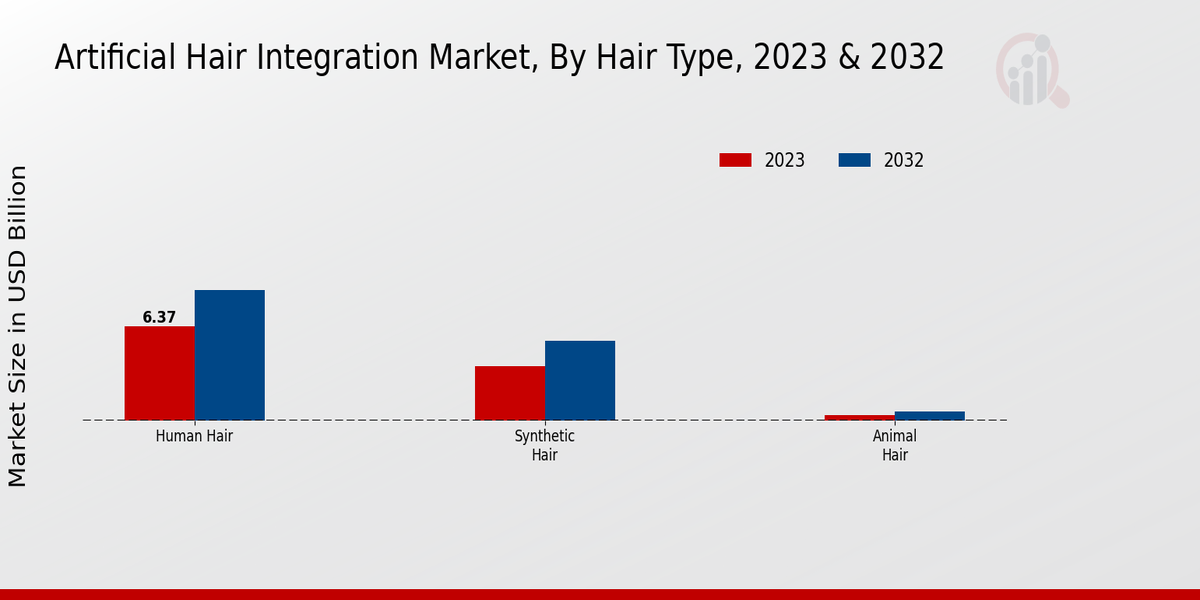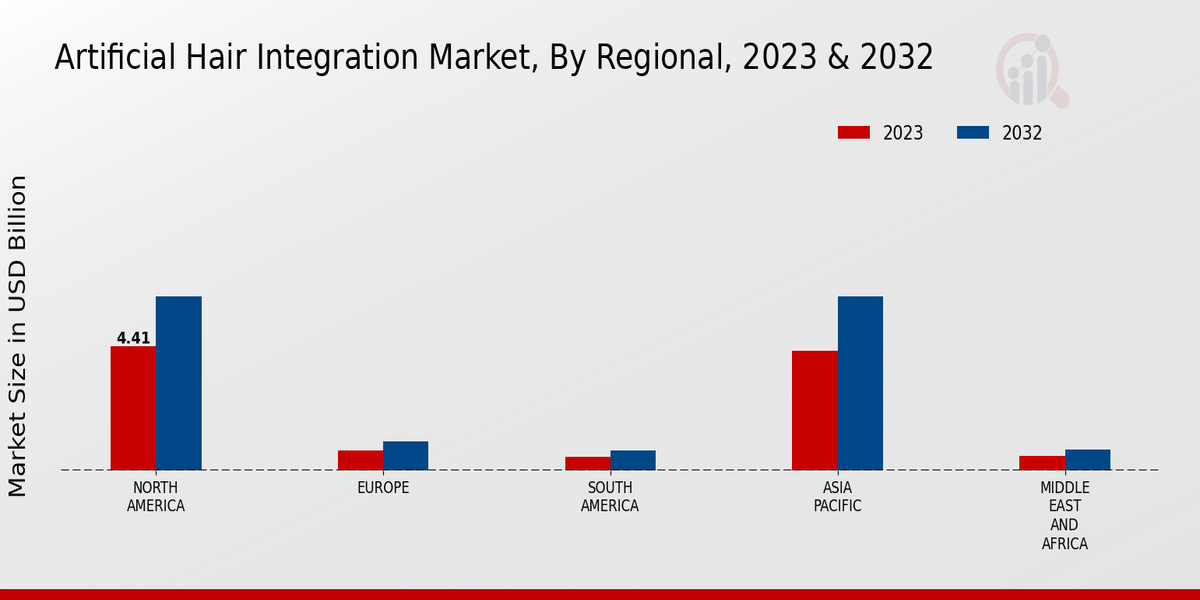Global Artificial Hair Integration Market Overview
Artificial Hair Integration Market Size was estimated at 11.23 (USD Billion) in 2024. The Artificial Hair Integration Market Industry is expected to grow from 11.69 (USD Billion) in 2025 to 16.75 (USD Billion) by 2034. The Artificial Hair Integration Market CAGR (growth rate) is expected to be around 4.1% during the forecast period (2025 - 2034).

Source: Primary Research, Secondary Research, MRFR Database and Analyst Review
Key Artificial Hair Integration Market Trends Highlighted
The global artificial hair integration market is primarily driven by the growing demand for non-surgical hair restoration solutions. Recent trends have shown a significant increase in the adoption of minimally invasive procedures, which has fueled the market growth. Moreover, the rising awareness about hair loss and its impact on self-esteem is further propelling the demand for effective hair integration techniques.
Key market drivers include the growing prevalence of alopecia, the aging population, and changing fashion trends. Opportunities for exploration and capture lie in the development of innovative technologies, such as virtual reality and augmented reality, for personalized hair integrations. Advancements in hair grafting techniques and the use of biocompatible materials are also expected to drive market growth in the coming years.
In recent times, the market has witnessed a shift towards natural-looking and undetectable hair integration solutions. This trend is driven by the increasing demand for seamless and discreet hair restoration options. Additionally, the growing popularity of online consultations and virtual hair analysis is providing consumers with greater accessibility and convenience.
Artificial Hair Integration Market Drivers
Rising Prevalence of Hair Loss and Hair-Related Conditions
The increasing prevalence of hair loss, hair thinning, and other hair-related conditions is a primary driver of the Global Artificial Hair Integration Market Industry. Factors such as genetics, hormonal imbalances, medical treatments, stress, and environmental factors contribute to hair loss, creating a growing demand for hair integration solutions. Artificial hair integration offers a non-surgical and effective way to address hair loss concerns, leading to its widespread adoption among individuals seeking to restore their hair's volume and appearance.
Growing Demand for Cosmetic Enhancements
The increase in demand for cosmetic treatments and procedures is one of the vital factors that have impacted the Global Artificial Hair Integration Market Industry. Artificial hair integration has become increasingly popular among those individuals who want to make themselves attractive and confident. It is an enthralling method to take care of hair problems seamlessly and look beautiful and flawless in every outfit. It is a versatile method through which individuals can achieve their desired length, volume, and texture of hair.The rising inclination of a large group of people towards cosmetic surgeries and method has reflected on the inclinations of those interested among the masses in the choice of artificial hair integration to enhance their appearance.
Technological Advancements and Innovation
The main driving force of the Global Artificial Hair Integration Market Industry is the rapid development of innovative technologies. Companies operating on the market are increasing their investments in R activities to develop new and improved artificial hair integration techniques and products. These trends result in the appearance of innovative attachment methods to ensure the convenient and secure fit of artificial hair as well as the development of high-quality synthetic hair fibers with the same texture as natural hair.From the technological standpoint, the artificial hair integration becomes more durable and aesthetically pleasing, which also explains its growth.
Artificial Hair Integration Market Segment Insights:
Artificial Hair Integration Market Hair Type Insights
The Hair Type segment of the Global Artificial Hair Integration Market is anticipated to exhibit significant growth in the coming years, owing to rising demand for natural-looking and versatile hair integration solutions. Human Hair: Human hair integrations offer a premium and authentic look, making them highly sought-after among consumers. The availability of various textures, colors, and lengths allows for seamless blending with natural hair, contributing to their popularity. The Global Artificial Hair Integration Market revenue for human hair integrations is projected to reach USD 5.62 billion by 2024.Synthetic Hair: Synthetic hair integrations provide an affordable and low-maintenance alternative to human hair. Technological advancements have led to the development of high-quality synthetic fibers that mimic the texture and appearance of natural hair, making them a preferred choice for budget-conscious consumers. The Global Artificial Hair Integration Market segmentation for synthetic hair integrations is estimated to account for USD 3.21 billion by 2024. Animal Hair: Animal hair integrations are less common compared to human and synthetic hair.However, they offer unique properties, such as durability and heat resistance, making them suitable for specific applications. The Global Artificial Hair Integration Market data for animal hair integrations is expected to witness modest growth in the coming years. Overall, the Hair Type segment offers diverse options to meet the varying needs of consumers. Human hair integrations dominate the market due to their premium quality and natural appearance, while synthetic hair integrations gain traction owing to their affordability and low maintenance.Animal hair integrations cater to niche applications, contributing to the overall market growth.

Source: Primary Research, Secondary Research, MRFR Database and Analyst Review
Artificial Hair Integration Market Integration Method Insights
The Global Artificial Hair Integration Market is segmented into several categories. One of the most notable is the Integration Method segment. The segment includes Weaving, Bonding, Clipping, Taping, and Microlinks. Weaving is a common method, where natural hair is braided and then hair extensions are sewn into these braids. This method provides a natural look and can last quite long if maintained properly – up to several months. Bonding is yet another common method that utilizes adhesives to attach hair extensions to the natural hair. It is more of a permanent solution than weaving and can last for approximately 6 months.Clipping is only a temporary solution with clips attaching hair extensions to natural hair. It is a quick solution to add length and volume to the hair; however, it is not as secure as weaving or bonding. Taping method uses double-sided tape with which hair extensions are attached to the natural hair. It is less damaging than bonding and holds for up to 8 weeks. Finally, microlinks is a long-lasting method that uses small metal rings to attach hair extensions to the natural hair – it lasts up to 3 months. The key market driver is the growing number of women of all ages opting to wear hair extensions.
Artificial Hair Integration Market Length Insights
The Global Artificial Hair Integration Market segmentation by length comprises Short, Medium, and Long. Among these, the Medium segment held the largest market share in 2023 and is projected to continue its dominance throughout the forecast period. The growing demand for natural-looking and seamless hair integration solutions drives the growth of this segment. Medium-length hair offers a balance between versatility and ease of maintenance, making it a popular choice for consumers seeking a subtle and flattering transformation. The Short segment is anticipated to witness a steady growth rate due to the increasing popularity of pixie cuts and bobs.The Long segment is expected to gain traction as consumers embrace longer lengths for a more glamorous and sophisticated look. The Global Artificial Hair Integration Market revenue from the Medium segment is projected to reach USD 5.6 billion by 2032, expanding at a CAGR of 4.2%. These insights are critical for market players to understand the evolving preferences of consumers and tailor their product offerings accordingly. By leveraging this data, manufacturers can develop targeted marketing strategies and cater to the specific needs of each segment, thereby driving growth and profitability in the Global Artificial Hair Integration Market.
Artificial Hair Integration Market Style Insights
The Style segment in the Global Artificial Hair Integration Market showcases a diverse range of textures, each catering to distinct consumer preferences. 'Straight' integrations, with revenues projected to surpass USD 3.2 billion by 2024, dominate the segment, owing to their versatility and ability to blend seamlessly with natural hair. 'Wavy' integrations, characterized by their soft, flowing texture, are expected to witness a steady growth, capturing a significant market share. 'Curly' and 'Coily' integrations, known for their voluminous, textured appearance, are gaining popularity among consumers seeking a more natural look.'Braided' integrations, offering a unique and intricate aesthetic, are also expected to contribute to the overall market growth. These diverse styles cater to a wide range of consumer tastes and preferences, driving the Artificial Hair Integration Market's expansion.
Artificial Hair Integration Market Texture Insights
The Texture segment of the Global Artificial Hair Integration Market is categorized into Fine, Medium, and Coarse. Fine hair integrations are designed for individuals with naturally fine hair, offering a seamless blend and natural appearance. The segment is expected to witness significant growth due to the rising demand for hair extensions and wigs that mimic the texture of natural hair. Medium hair integrations cater to individuals with medium-density hair, providing volume and length while maintaining a realistic look. This segment is projected to hold a substantial market share due to its versatility and suitability for a wide range of hair types.Coarse hair integrations are specifically tailored for individuals with thick, coarse hair, offering durability and a natural-looking finish. With the growing popularity of protective hairstyles and the increasing demand for hair extensions among individuals with coarse hair, this segment is anticipated to experience notable growth in the coming years. Overall, the Texture segment plays a crucial role in the Global Artificial Hair Integration Market, catering to diverse hair types and preferences.
Artificial Hair Integration Market Regional Insights
The Global Artificial Hair Integration Market is segmented into North America, Europe, APAC, South America, and MEA. The North American region accounted for the largest share of the market in 2023, and is expected to continue to dominate the market throughout the forecast period. The growth of the North American market is attributed to the increasing demand for artificial hair integrations among celebrities and fashion-conscious individuals. Europe is the second largest market for artificial hair integrations, and is expected to experience significant growth in the coming years.The growth of the European market is attributed to the rising popularity of hair extensions and wigs among women in the region. The APAC region is the third largest market for artificial hair integrations, and is expected to witness the fastest growth in the coming years. The growth of the APAC market is attributed to the increasing disposable income and the growing awareness of fashion trends among consumers in the region. South America and MEA are relatively smaller markets for artificial hair integrations, but are expected to experience moderate growth in the coming years.

Source: Primary Research, Secondary Research, MRFR Database and Analyst Review
Artificial Hair Integration Market Key Players And Competitive Insights:
Major players in Artificial Hair Integration Market are constantly innovating and developing new products to meet the evolving needs of consumers. These companies are investing heavily in research and development to create more natural-looking and comfortable hair integration systems. Some of the leading Artificial Hair Integration Market players include HairUWear, Lordhair, and Lavivid Hair. The Artificial Hair Integration Market industry is highly competitive, with a number of established players and new entrants vying for market share. Leading Artificial Hair Integration Market players are focusing on expanding their product portfolio, increasing their production capacity, and investing in marketing and branding initiatives to gain a competitive edge. The Artificial Hair Integration Market is expected to witness significant growth in the coming years, driven by factors such as rising awareness about hair loss treatments, increasing disposable income, and growing demand for non-surgical hair replacement solutions.Among the leading players in the Artificial Hair Integration Market, HairUWear is a global leader in the hair replacement industry. The company offers a wide range of hair integration systems, including wigs, hairpieces, and toppers, to cater to the diverse needs of consumers. HairUWear is known for its innovative hair integration techniques and its commitment to providing high-quality products and services. The company has a strong presence in North America, Europe, and Asia, and it is expanding its reach into new markets.HairUWear's main competitor, Lordhair, is another leading player in the Artificial Hair Integration Market. The company offers a range of hair integration systems, including wigs, hairpieces, and hair extensions, to meet the needs of both men and women. Lordhair is known for its high-quality hair products and its commitment to providing excellent customer service. The company has a strong presence in North America, Europe, and Asia, and it is expanding its reach into new markets.
Key Companies in the Artificial Hair Integration Market Include:
Artificial Hair Integration Market Industry Developments
The global Artificial Hair Integration market is projected to grow from USD 10.36 Billion in 2023 to USD 14.85 Billion by 2032, at a CAGR of 4.08% during the forecast period. The increasing prevalence of hair loss and the growing popularity of hair integration techniques are the key factors driving the growth of this market. The rising disposable income and the increasing awareness about hair loss treatments are also contributing to the market's growth.Recent news developments and current affairs in the Global Artificial Hair Integration Market include:In January 2023, HairClub, a leading provider of hair loss solutions, announced the launch of its new line of artificial hair integration systems.In March 2023, Vinci Hair Clinic, a hair restoration clinic, announced the opening of its new clinic in London, UK.In May 2023, the International Society of Hair Restoration Surgery (ISHRS) announced the release of its new guidelines for the ethical practice of hair transplantation and hair integration.
Artificial Hair Integration Market Segmentation Insights
| Report Attribute/Metric |
Details |
| Market Size 2024 |
11.23 (USD Billion) |
| Market Size 2025 |
11.69 (USD Billion) |
| Market Size 2034 |
16.75 (USD Billion) |
| Compound Annual Growth Rate (CAGR) |
4.08% (2024 - 2032) |
| Report Coverage |
Revenue Forecast, Competitive Landscape, Growth Factors, and Trends |
| Base Year |
2023 |
| Market Forecast Period |
2024 - 2032 |
| Historical Data |
2019 - 2023 |
| Market Forecast Units |
USD Billion |
| Key Companies Profiled |
Olaplex ,SexyHair ,BeautyWorks ,Klix Extensions ,Balmain Hair Couture ,R+Co ,Hotheads Extensions ,Hairdreams ,NBR Extensions ,Schwarzkopf Professional ,Bellami Hair ,Invisible Bead Extensions ,Great Lengths ,Redken |
| Segments Covered |
Hair Type ,Integration Method ,Length ,Style ,Texture ,Regional |
| Key Market Opportunities |
Rising disposable income Increasing demand for naturallooking hair extensions Growing awareness about hair loss treatments Technological advancements in hair integration techniques Ecommerce platforms driving sales of artificial hair integrations |
| Key Market Dynamics |
Rising demand technological advancements growing disposable income increasing hair loss concerns and emerging ecommerce platforms |
| Countries Covered |
North America, Europe, APAC, South America, MEA |
Frequently Asked Questions (FAQ) :
The global Artificial Hair Integration market size was valued at USD 11.23 billion in 2024 and is projected to grow at a CAGR of 4.1% to reach USD 16.75 billion by 2034.
The key regions of the Artificial Hair Integration market are North America, Europe, Asia-Pacific, and the Rest of the World. North America is the largest market, followed by Europe and Asia-Pacific.
The key applications of Artificial Hair Integration include hair loss, hair thinning, and hair styling. Hair loss is the most common application, accounting for over 50% of the market.
The key competitors in the Artificial Hair Integration market include Aderans Co., Ltd., Cesare Ragazzi Laboratories S.p.A., Farouk Systems, Inc., GFH, Inc., Hair Direct, Inc., Hair Restoration Laboratories, Inc., Jon Renau, L'Oréal S.A., and Vinci Hair Clinic.
The key growth factors of the Artificial Hair Integration market include rising demand for hair loss solutions, increasing disposable income, and growing awareness of hair integration techniques.
The key challenges of the Artificial Hair Integration market include high cost of hair integration procedures, lack of skilled professionals, and social stigma associated with hair loss.
The key opportunities of the Artificial Hair Integration market include advancements in hair integration techniques, increasing demand for non-surgical hair loss solutions, and growing popularity of hair integration among celebrities and influencers.
The key trends of the Artificial Hair Integration market include increasing demand for customized hair integration solutions, growing popularity of online hair integration services, and rising adoption of non-invasive hair integration techniques.
The key technological advancements in the Artificial Hair Integration market include the development of new hair integration materials, the use of artificial intelligence (AI) for hair integration design, and the introduction of robotic hair integration systems.
The future outlook of the Artificial Hair Integration market is positive. The market is expected to continue to grow over the next decade, driven by rising demand for hair loss solutions and increasing disposable income. Technological advancements and growing awareness of hair integration techniques are also expected to contribute to the growth of the market.

















